Dinnington High School
Dinnington High School is a coeducational comprehensive school and Sixth Form in Dinnington, in the Metropolitan Borough of Rotherham, South Yorkshire, England.[1] With origins dating back to 1743,[2] Dinnington High School is the oldest secondary school in the Metropolitan Borough, and the second oldest in South Yorkshire. It was one of the first comprehensive schools to be established in the United Kingdom and is notable for being one of the only schools in the world to have buildings designed by famous architect Sir Basil Spence.[3] Former pupils of Dinnington High School are Old Dinnonians, and include 19th century criminal Charles Peace[4] and historian Ebenezer Rhodes.[5]
| Dinnington High School | |
|---|---|
 | |
 Dinnington High School in 2016 | |
| Address | |
Doe Quarry Lane , , S25 2NZ England | |
| Coordinates | 53.37401°N 1.20476°W |
| Information | |
| Type | Academy |
| Motto | Achieving Excellence |
| Established | 1743 (Established) 1935 (Relocated) |
| Local authority | Rotherham |
| Department for Education URN | 141730 Tables |
| Ofsted | Reports |
| Headmaster | Mr Phil Davis |
| Gender | Mixed |
| Age | 11 to 18 |
| Enrolment | 1,231 |
| Capacity | 1,444 |
| Campus size | 50 acres |
| Houses | Segrave, Hatfield, Athorpe, Osborne |
| Colour(s) | Red Green Yellow Blue |
| Alumni | Old Dinnonians |
| Former names | The Dinnington School (1743) Dinnington Senior Boys' School (1935–1957) Dinnington Senior Girls' School (1935–1957) Dinnington Secondary Modern School (1957–1963) Dinnington High School (1963–1974) Dinnington Comprehensive School (1974–2015) |
| Uniform | White Shirt, House Tie, Black Blazer, Black Jumper, Black Trousers |
| Website | https://www.dinningtonhigh.co.uk/ |
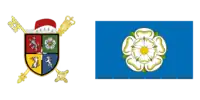 | |
The school is based entirely on a 50 acre estate, containing all academic buildings and facilities, including the ruins of an 18th Century Folly[6] and one of England's best preserved 20th century traditional gymnasiums.[7] There are 984 students in the school.[8] All students are day pupils between the ages of 11 and 18, and are predominantly from Dinnington and the surrounding settlements, admissions to the lower school are non-selective; the sixth form offers places on academic conditions.[9]
History


Early Years
Dinnington High School was first founded in 1743 as The Dinnington School.[10] It was a small dame school which existed within the town,[11] only large enough to accommodate the local demands at the time. As the population of Dinnington grew the school was expanded and moved locations a number of times.[12] The Fisher Education Act of 1918 had made Secondary Education compulsory up to the age of 14, and this was now putting a strain on the Mixed Department of the Dinnington School. In order to relieve stress on the Dinnington School, talks of a new Secondary Department in Dinnington began in 1931, the former school would become a Junior School, with the over-10s moving to the new Secondary Department.[13]
The new school was built on the grounds of Throapham Manor, and was opened by Sir Percy Jackson (chair of the West Riding Local Education Authority) in 1935 as Dinnington Senior Boys' School and Dinnington Senior Girls' School. It consisted of a single timber building at the cost of around £21,300[14] which was divided into girls' and boys' departments.[15] In 1938 the building was extended and a separate gymnasium was added. The Manor House was also used for teaching and housed 11 classrooms until its demolition in the 1970s. The woodland at the back of the school still contains the remains and ruins of old outbuildings.
War & Military Occupation
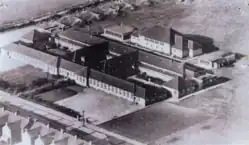
After the outbreak of the Second World War, Air raid shelters were completed on school grounds in April 1940,[16] and the school could evacuate to them in under two minutes. The school turned over its playing fields for farming vegetables. Bees were also kept for honey, and a pig-sty was built to house 11 pigs.[17] The school closed for a fortnight, during this time staff took turns by twos in being present from 9 – 8 and in resisting any attempts on the part of unwanted persons to commandeer the premises.
In 1939 Lieutenant Pepper and Sergeant Major Cressey were keen to obtain school buildings as barracks.[18] They had received instructions to take only half the school and were anticipating immediate permission of such a step. The military occupied the school on Thursday 14 September 1939 at about 13:30. The Boys' Department was broken up into groups of 50 pupils who were taught in the school on successive days. The girls' Domestic Science rooms were used to provide school meals, as the servery was in use by the soldiers.[19]
Objections by the school were made, as presence of soldiers made Dinnington a military target, as a result, all military authority were asked to leave by 30 September. By way of recompense, the military dug the school regulation military-occupation trenches.
The Merger and Expansion
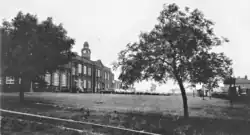

In 1957 the two halves merged to form the coeducational Dinnington Secondary Modern School, and at that point there were already plans for a further merger with the secondary technical element of the neighbouring Dinnington Chelmsford Technical College to create the area's first comprehensive school.[20]
This comprehensive school, Dinnington High School, opened on 23 September 1963 (a formal opening taking place a year later, conducted by Jack Longland). The area between the two merging establishments was developed with a new campus designed by Basil Spence & Partners. This campus consisted of four house bases and a sixth form college, along with a new main hall and a second gym.[21]
The School is credited with the introduction of Rugby Union Football to the local area and in turn to the establishment of Dinnington Rugby Club[22] which has produced players for the county and for Senior clubs such as Rotherham, Harlequins and Northampton.
The campus continued to be extended following the merger, with the addition of a swimming pool, technology block, sports hall, new sixth form base and library in the 1970s and 1980s.[23]
The school came under the control of the new Rotherham Metropolitan Borough Council in 1974 and was renamed Dinnington Comprehensive School. Soon after the school uniform changed for the very first time, dropping the original black blazer and tie for more casual polo shirts and blue jumpers embroidered with the schools crest – this also briefly changed to black jumpers, before the school returned to its traditional black blazer and house tie.
Fire, Arson and Redevelopment


In the late 1900s, Dinnington had a large problem with fire, with many students having been caught playing with fire on school grounds. This was especially problematic as much of the original buildings were timber built.[24] On 20 August 1996 the original school building (which still made up close to half of the teaching campus) was set alight by arsonists;[25] the latest in a succession of arson attacks on the school. The fire destroyed the building and took with it student course-work and several computer rooms.[26] House-bases were re-fitted into classrooms and this led to the brief phasing out of the house system at Dinnington, which had existed in various forms even during the pre-merger days.
In 1997 a new school building was opened, standing on the site of the burnt-out original.[27] The brick-built two-storey building called 'New Build' allowed a long-standing "ghetto" of 1960s-built portable classrooms (known as the Terrapin Plateau) to finally be retired. Several other aging prefab buildings on campus have been demolished in recent years.
On 27 January 2005 the school announced its success in a bid to become a specialist school in Science and Engineering.[28] Previously, in 1993, it had been designated a technology school as part of a previous Department of Education grant scheme.
Dinnington became an academy on 1 February 2015. At the same time, the school name reverted to Dinnington High School.
The School Site
Overview
There are four entrance ‘gates’ to the school: The main entrance is up through the Main Gate which allows vehicular access; Pedestrian access is allowed through the Postern Gate (off Manor Lane), Skinner’s Gate (from Skinner’s Wood), and the Coach Park Gate, Throapham Bar[29] is no longer used as an entrance way. The school faces Doe Quarry Lane, starting with The New Build, the newest part of the school. Behind The New Build is the Old Gym which is the oldest of the timber buildings still standing.[30] To the left of the Old Gym is the 'Art Block, and Main Hall which is connected by flyover to Admin House, Hatfield House, Osborne House, 6th Form Base, Segrave House and Athorpe House, all of which are timber buildings that house communal areas and some departments.[31] Sandwiched between the quadrangles are brick infills which serve as kitchens. Beyond Segrave house and over the service road is the Old College Building'. Behind the house bases is an area that used to be known as the Terrapin Plateau or 'The Ghetto' amongst students – though this part of the school has long been demolished. To the right of the Terrapin Plateau is the Technology Block and New Gym. Towards the back end of the school is the Sports Hall,[32] Pavilion, and Drama/Exams Block. The White House was the final building at the back of the site, it acted as residence for the groundskeeper until School House and The Lodge were built on Doe Quarry Lane. There are the remains of some of the outbuildings in Skinner's wood, including the remnants of the glass-house and a folly known as the school crypt.[33]
Architectural Interest
As the very first comprehensive school in the region, Dinnington High School was intended to be a showpiece to the country on the progression of education in the UK; it is for this reason that Dinnington boasts a well equipped campus for a British state school. Half of the schools current buildings were designed by Sir Basil Spence, including the 1950s house complex to the west of the school; it is notable for its geometric layout and suspended glass corridors.[34] In 2012 The school's Old Gym was described by Woodsetts History Society Charity as '[The] most well preserved example of traditional 20th century public school architecture in England'.[35]

School Houses

Dinnington has four school houses,[36] Athorpe House, which was once reserved for the Sixth Form, has been reintroduced into the main school again as each year group is now allocated to a house. The Y7s of Sept 2022 are the first to bring Athorpe house back. Year 11 students now represent all houses with a school badge on a black tie. The school’s inter-house sports day is held annually, where students from each house contest the house cup.
Students remain in their house until they leave the school. Each house has its own house tie. The four houses took their names and badges from historical local land-owning families:
Hatfield House
The Hatfield badge is a white cinquefoil on a green background as also seen on the old Hatfeild Inn sign. The Hatfeild Family were land-owners in Laughton-en-le-Morthen in the 17th century.[37] Hatfield House is positioned between Osborne House and the Main Hall. It is a two-storey timber building from the 1960s, and contains offices, and a common/dining area. The building is connected to the Main Hall by a flyover running east, and to Osborne House via a west running flyover – there is also access to The 6th Form Base at the Osborne/Hatfield flyover junction. Hatfield was the first to win the house cup in 1957, and have claimed the cup 18 times since.
Osborne House
The Osborne badge is an heraldic ruffled tiger on a blue background. Osborne was the family name of the Duke of Leeds who had property in Kiveton Park.[38] Osborne is located between Segrave and Hatfield, it is a near replica of Hatfield House, and is connected to Hatfield and Segrave by flyover, and Athorpe by the flyover junction. Osborne specialised in Geography, until the department moved to the newly complete New Build, since then Osborne has houses the schools Applied subjects including IT, business, and a range of social sciences. Osborne has won the house cup a total of 28 times, the most in the school. Osborne are the only house to win the cup for 7 successive years.
Segrave House
The Segrave badge is an heraldic lion on a red background. Segrave is named after the de Segrave family who owned much of the local area in the 16th century.[39] The Segrave House Building is the tallest building in school, with three floors. The house has the largest floorspace, with an extension added in 2008, it is the only house that is separated from the school kitchens. Segrave is connected to Osborne and Athrope via flyover. Segrave specialises in science, it houses most of the school's laboratories on its upper floors. Segrave have won the house cup 11 times.
Athorpe House
The Athorpe badge is a falcon on a yellow background. Athorpe is named after the family who lived at Dinnington Hall back in the 17th century.[40] The building also houses science laboratories. Since the lower school fire, Athorpe was refitted with classrooms, eliminating any downstairs communal space. Athorpe have won the house cup 4 times.
Historically, each house was linked to disciplines: Hatfield, academic; Osborne, sports; Segrave, arts; Athorpe was originally the art block.[41]
Uniform
Day Uniform
For as long as the school has been around, students have worn deep black blazers, embroidered with the school crest, trousers and jumpers, with white shirts and ties. Girls traditionally wore black sleeveless dresses with white, large collared shirts, but this changed many years ago. For a brief spell, students wore blue and black jumpers over white polo shirts, but the school has since reverted to a more traditional approach. The wearing of gowns has also dissolved over the years, they were worn especially on external visits to religious ceremonies, but such occasions have since stopped.
Sport
For sport, navy and light blue shirts and shorts are worn with blue socks. Cricket whites are worn for competitive cricket, and blue and yellow hooped shirts for rugby. Girls wear blue skirts instead of shorts.
School Culture and Traditions
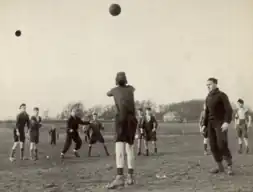
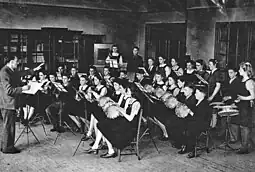
Language and Dialect
Typical of the region, most students use Yorkshire dialect paired with a school slang, that is unique to the school and its students. Examples include unconventional terms for the summer and winter holidays; 'picking', and 'thread' – as well as teachers, who are called 'flats', and the head teacher, who is the 'bov'.[42] Martin Goodall included a list of this vocabulary in their article: Surviving Dinnington, The Art of being a Dinnonian (2016).
Potato Picking
In summer, potato picking was carried out in the local area, and farmers paid school boys to help yield the crop. Historically, the school allowed students out into the fields with permission to help the farmers in the form of a blue card – those without blue cards were sent back to school. This had a detrimental impact on attendance, with the Boys' Department seeing attendances as low as 40%.[43]
Science Stores
The Science Stores: The school science department has an old, and rather strange collection of specimens.[44] In the Segrave House stores are a large collection of pickled animals in large glass containers. Amongst these animals are eels, rats and a pig. Although this collection is not used in the curriculum, it is brought out once every year at the schools open day. The department also has what they claim to be a real life human skeleton, donated to the school some years ago.[45]
Science and Engineering
Dinnington has a respected reputation in Science and Engineering, including Biology, Physics, Chemistry, General Engineering, Woodwork and Product Design. The school has been a specialist school in Science and Engineering[46] and a designated technology school. The science department is larger than in most schools, spread across 12 well equipped laboratories in two buildings.
The Design & Technology department (which houses Engineering) also has its own building, which has been extended over the years. The building has a variety of rapid prototyping and manufacturing machinery, including 3D printers, laser cutters, lathes and vacuum formers. The so called 'Technology Block' boasts three large multi-materials workshops, a lathe workshop, a textiles classroom, two teaching classrooms, two CAD suites, a saw room, and materials commons as well as staff offices.
Controversies
Security
In 2017 the murder of Dinnington Student, Leonne Weeks, just 2 minutes away from the school, raised concerns about the security of the school site. Previously the school had been left relatively exposed to the public, with the main gate left open throughout the school day, and no barrier to academic buildings. With the murderer still at large, concerns about student safety forced the school to act quickly. Security officers patrolled the school for a week, whilst temporary fencing was erected.[47] Permanent fencing and three additional access controlled gates were added shortly after.
Fencing of School Playing Fields
In 2013, the school took the decision to fence off the extensive playing fields[48] and plateau athletics field towards Throapham. This led to disputes by local residents, who often used the school grounds for exercise and leisurely activities. The school argued that the fencing was necessary to prevent vandalism of the estate, and disruption of school PE classes.
In Media and Popular Culture
BBC Panorama
On 14 November 1961, TV journalist James Mossman, augmented by a BBC film unit, arrived at Dinnington to make a Panorama item on "Corporal Punishment in Schools". It would examine contrasting discipline in two schools in the West Riding; the other being a school in Leeds. On the 29th there was some follow-up shooting. And then on 4 December 1961, programme 264 of Panorama aired on the BBC.[49]
Royal Visits
The school has had multiple royal visits throughout its history, including that of Prince Edward,[50] and the Duke and Duchess of Gloucester.
Notable People
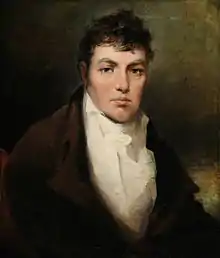

Notable Alumni
Former pupils[51] of Dinnington High School are Old Dinnonians. A full list of Alumni can be found on the school Old Boys website.
Historical Figures
- Ebenezer Rhodes, topographer, publisher, master cutler and artist
- Barbara Hofland, writer
- Charles Peace, English murderer and fugitive[52]
- Sergeant Robert Ring, police officer who captured the Yorkshire Ripper
Music and Popular Culture
- Eliot Kennedy, songwriter and producer for Billie Piper, The Spice Girls and Gary Barlow
- Benjamin Frith, concert pianist
- Savanna Darnell, contestant on Love Island in 2018
- Isabel Canning, Actor
Sport
- Tom Atter, footballer for Rotherham United
- Richard Marshall Neal, footballer for Birmingham City
- Paul Arthur Marshall, cricketer
- Walker Wainwright, first-class cricketer
- Jade Moore, footballer for Manchester United Women and The Lionesses
- Walter Boyes, footballer for West Bromwich Albion and England
- Joe Cockcroft, footballer for West Ham United, Sheffield Wednesday and Sheffield United
Military
- William Henry Johnson (VC), sergeant in 1/5th Battalion
Notable Staff
- Cec Thompson, professional rugby league footballer (Economics)
- Joe Cockcroft, footballer for West Ham United, Sheffield Wednesday and Sheffield United (PE)
- Dana Abdulkarim, First Muslim and Arab woman to compete for England Internationally & first Hijabi Muslim Woman to qualify to teach PE in England (PE)[53]
- Rob Rouse, Comedian and Actor, including 8 Out of 10 Cats, and Coronation Street (Geography)[54]
- Joe Carnell Jnr, Reverend and The Makers (History)[55]
Headteachers
18th century
- Ms Agatha Fallow (1743–1752)
- Ms Gladys Uppingham (1752–1756)
- Ms Julia Fretwell (1756–1772)
- Ms P Richards (1772–1778)
- Ms Elizabeth Yard (1778–1793)
19th century
- Ms D Heckworth (1793–1802)
- Mr A Marshall (1815–1826)
- Mr William Bont (1826–1841)
- Mr J.A. Tyne (1841–1854)
- Dr M Fabricant (1854–1861)
- Dr Horace Alsopp (1861–1872)
- Mr David Alsopp (1872–1873)
- Mr P Oswald (1896–1898)
- Mr Anthony Race (1898-unknown)
20th century
- Dr R.J. Pickard (1935–1946) Boys' Department
- Mr E.J. Ducker (1946–1948) Boys' Department
- Mr William G. Davies (1948–1950) Boys' Department
- Mr E.M. Spelman (1950–1956) Boys' Department
- Mr G.H. Butterworth (1935–1942) Girls' Department
- Miss Elsie Goldthorpe (1943–1956)Girls' Department
- Miss Elsie Goldthorpe (1956–1963)
- J.E.W. Moreton (1963–1975)
- Mr Brian Ingham (1975–1983)
- Mr Gordon Forster (1983–1997)
21st century
- Miss Jean Nicholson (1997–2006)
- Miss Sue Carhart (Acting, 2006–2007)
- Mr Paul Blackwell (2007–2015)
- Mr Chris Eccles and Mr Ian Holborn (2015–2016)
- Ms Rebecca Staples (2017–2023)
- Mr W Barsby (Acting, 2023)
- Mr Phil Davis (2023)
Ofsted inspections
Since the commencement of Ofsted inspections in September 1993, the school has undergone eight full inspections:
| Date of inspection | Outcome | Reference |
|---|---|---|
| 7–?? April 1997 | ??? | |
| 5–9 January 2001 | Good | Report |
| 6–7 March 2007 | Satisfactory | Report |
| 11–12 November 2009 | Satisfactory | Report |
| 23–24 January 2013 | Requires improvement | Report |
| 9–10 April 2014 | Good | Report |
| 7–8 November 2017 | Requires improvement | Report |
| 11–12 February 2020 | Requires improvement | Report |
References
- "Welcome to Dinnington High School". Dinnington High School. Retrieved 28 May 2019.
- "hall43.co.uk". www.hall43.co.uk. Retrieved 1 July 2023.
- Walford, Sarah (2011). Architectural Heritage. Architectural Heritage Society of Scotland. pp. 137–156. ISSN 1350-7524.
- "Notable Alumni". Old Dinnonians. Retrieved 26 September 2023.
- "Notable Alumni". Old Dinnonians. Retrieved 26 September 2023.
- "Crypt Photos". Old Dinnonians. Retrieved 27 October 2023.
- "The Old Gym | School Buildings". Old Dinnonians. Retrieved 27 October 2023.
- "Dinnington High School – Profile (2023)". snobe.co.uk. Retrieved 26 September 2023.
- "Dinnington High School – GOV.UK". www.get-information-schools.service.gov.uk. Retrieved 26 September 2023.
- "History". Old Dinnonians. Retrieved 27 October 2023.
- "Schools". Dinnington Heritage Society. Retrieved 1 July 2023.
- "History". Old Dinnonians. Retrieved 27 October 2023.
- "hall43.co.uk". www.hall43.co.uk. Retrieved 27 October 2023.
- "hall43.co.uk". www.hall43.co.uk. Retrieved 27 October 2023.
- "hall43.co.uk". www.hall43.co.uk. Retrieved 1 July 2023.
- "Photo Archive". Old Dinnonians. Retrieved 27 October 2023.
- "hall43.co.uk". www.hall43.co.uk. Retrieved 27 October 2023.
- "hall43.co.uk". www.hall43.co.uk. Retrieved 1 July 2023.
- "hall43.co.uk". www.hall43.co.uk. Retrieved 27 October 2023.
- "History". Old Dinnonians. Retrieved 27 October 2023.
- "hall43.co.uk". www.hall43.co.uk. Retrieved 27 October 2023.
- "Celebrating 50 Years". Dinnington Heritage Society. Retrieved 27 October 2023.
- "gym". www.avwoman.co.uk. Retrieved 27 October 2023.
- "News coverage of Dinnington Comprehensive School fire – Calendar & Look North (21/08/96)". Retrieved 27 October 2023.
- "Dinnington High School". Dinnington Heritage Society. Retrieved 27 October 2023.
- "News coverage of Dinnington Comprehensive School fire – Calendar & Look North (21/08/96)". Retrieved 27 October 2023.
- "Hall 43: a Dinnington Comprehensive School archive". www.avwoman.co.uk. Retrieved 27 October 2023.
- enquiries@ofsted.gov.uk, Ofsted Communications Team (17 September 2023). "Find an inspection report and registered childcare". reports.ofsted.gov.uk. Retrieved 27 October 2023.
- "Throapham Bar | School Buildings". Old Dinnonians. Retrieved 27 October 2023.
- "The Old Gym | School Buildings". Old Dinnonians. Retrieved 27 October 2023.
- "Hatfield House | School Buildings". Old Dinnonians. Retrieved 27 October 2023.
- "The Sports Hall | School Buildings". Old Dinnonians. Retrieved 27 October 2023.
- "The Crypt | School Buildings". Old Dinnonians. Retrieved 27 October 2023.
- Architectural Heritage Society of Scotland. Building for Education (1 ed.). ISSN 1755-1641.
- "The Old Gym | School Buildings". Old Dinnonians. Retrieved 27 October 2023.
- "School Houses". Dinnington High School. Retrieved 1 July 2023.
- "School Houses". Dinnington High School. Retrieved 27 October 2023.
- "School Houses". Dinnington High School. Retrieved 27 October 2023.
- "School Houses". Dinnington High School. Retrieved 27 October 2023.
- "School Houses". Dinnington High School. Retrieved 27 October 2023.
- "hall43.co.uk". www.hall43.co.uk. Retrieved 27 October 2023.
- "Dinno Lingo". Old Dinnonians. Retrieved 27 October 2023.
- "hall43.co.uk". www.hall43.co.uk. Retrieved 1 July 2023.
- "Extra Curricular". Dinnington High School. Retrieved 27 October 2023.
- "Dinno Lingo". Old Dinnonians. Retrieved 27 October 2023.
- "OFSTED Report".
- "Newsletter" (PDF).
- "Worksop Guardian Article Online".
- "hall43.co.uk". www.hall43.co.uk. Retrieved 1 July 2023.
- "The Daily Telegraph 27 Nov 1998, page 30". Newspapers.com. Retrieved 18 June 2023.
- "Notable Alumni". Old Dinnonians. Retrieved 26 September 2023.
- "Notable Alumni". Old Dinnonians. Retrieved 18 September 2023.
- "Dana Abdulkarim". Sporting Heritage. Retrieved 26 August 2023.
- "hall43.co.uk". www.hall43.co.uk. Retrieved 24 October 2023.
- "Staff". www.avwoman.co.uk. Retrieved 24 October 2023.